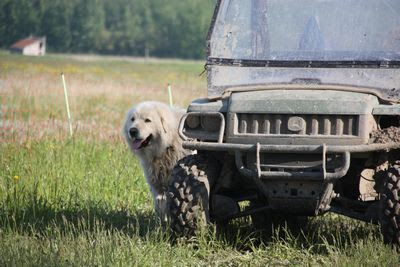This is an article that I recently wrote for a local newspaper, it was brought to my attention by Gary Allen that Canada has to review the use of this predacide under the agreements made with other OECD countries.
Up until now, Canada has not complied with this review...
Earth Day has come and gone, some people may have stopped and paused for a moment and thought about our impact on the world, climate change and other environmental issues facing all of us in the years to come. Each and everyone have a responsibility to try to prevent poisonous substances to filter into our environment, ground and water courses. For many years Canadians have been using certain poisons to control “pest” animals, however few understand the impact that these poisons have on the environment.
Have you ever heard of Sodium Fluoroacetate? Not likely. However, most ranchers know this substance under is common name 1080. The name "1080" refers to the original catalogue number of this poison and this later became its brand name. It is an organofluorine chemical compound and is used as a metabolic poison.
This substance is one of the most toxic poisons that Canadians are subjected to. It is commonly used as a predator control substance and that use alone, is of course highly controversial.
It was brought to my attention by Gary Allen from Sointula, BC, that that the Minister of Health has the responsibility and obligation to initiate a special review of a “registered pest control product when a member country of the OECD countries (Organization for Economic Co-operation and Development) prohibits all uses of an active ingredient for health or environmental reasons. Slovenia, a recent member of the OECD has banned the use of Sodium Fluoroacetate (Compound 1080) in its country.”
Allen points out that this review has not taken place in Canada and feels that people are unaware of the dangers it poses to their health and communities.
What does this mean and why do we need 1080 in Alberta?
Allen explains that 1080 is a colorless, odorless salt which is highly soluble in water.
It is highly toxic to all mammals (including humans) and birds.
An oral dose of 2-5 mg/kg of this substance is sufficient to be lethal in humans.
There is no known antidote.
It slowly decomposes in soil and water in low temperatures, resulting in continued persistence in the environment.
It is banned in a number of countries and states such as California, South Africa and China to name a few.
Due to its high toxicity and slow decomposition in soil and water, it poses serious environmental risks as it is soluble in water and can easily poison water sources.
Sodium Fluoracetate is classified as a restricted product and is regulated under the Federal Pest Control Products.
The government of Canada has authorized two provinces (Alberta and Saskatchewan) to use this toxic substance as a pest control product. The federal government has devolved down to the provincial governments, the application of this substance by the farming and ranching community. The Alberta government has also devolved the responsibility of monitoring, inspecting and training the end user of this product to their local municipal governments. The actual distributor of this highly toxic substance is the landholder.
1080 is primarily a predacide (used to poison predators).The coyote is the primary animal being targeted when using compound 1080. The Alberta government has published a manual called “Coyote Predation Control Manual and Study Guide”. In this manual they outline the use of various poisons and other methods to reduce livestock predation. However, before using poisons, this manual does highlight the use of other, management and husbandry methods to prevent predation.
![]()
It states: “The first consideration, when conflict exists between livestock and coyotes, is the management of livestock to prevent situations that induce or invite predation. Sound husbandry practices reduce interactions between livestock and coyotes. Land use practices must be analyzed and the best use patterns considered before coyote conflicts arise.” It later goes on to describe other ways to reduce coyote predation; it states categorically that “Guard dogs are the most useful tool for reducing livestock losses to predators.” The manual outlines some other ways to deal with coyote predation before resorting to the use of dangerous poisons.
While it is important to the ranching/farming community to protect themselves from predation on their livestock, there are many effective (non lethal) predator control methods. Allen states that poisoning is simply bad management. It poses a direct risk to the rancher, his family, children, his livestock, the environment and water resources. It is lethal to domestic pets and is a non specific poison which means poisoning of non targeted animals can easily occur.
M Sherley concludes; in a research paper “Is Sodium Fluoroacetate (1080) a humane poison?” that it is a distressing, painful and brutal death and should not be regarded as a humane way to dispose of wildlife.
Now, that we know what Sodium Fluoroacetate is and does, Allen explains that it is the responsibility of the Minister of Health to review the use of 1080 and to decide whether the use of 1080 should be banned in Canada. Allen feels that the public are not enough aware of the dangers and potential misuse of this substance and he looks forward to the day when the use of 1080 is banned.
Thanks Gary for sending me this information!
![]()
![]()




























